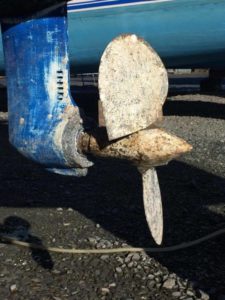
Maritime Marketplace review
February 23, 2017Letter From the Chairman
March 18, 2017
Marine Growth on Propeller – How clean is my running gear?

- More vibration than there used to be when underway
- Noticeably slower through the water
- Using more fuel to go the same distance
- You don’t want to look – it’s been a while!
Like most problems with boats, the answer may be different for each boat. For example, using your boat regularly will help to keep the bottom cleaner. And some waterways have more marine growth than others.
So what are the options? Should I use propeller antifouling paint?
Water turbulence, high speed and vibration make running gear the most difficult underwater surface to coat.
Apart from storing your boat out of the water, you can:
- Slip more frequently to clean your prop – which can get expensive, or
- Protect your propeller to minimise marine growth.
I’ve always used anti foul. What’s wrong with that?
- The ‘metal’ used in some anti fouls can have a detrimental effect, accelerating electrolysis in salt water. Your propeller becomes the sacrificial anode instead of the zinc.
- Antifoul is not flexible, but quickly cracks and falls off. In the propeller wash, vibration and ‘harmonics’ impact on props, shafts and rudders.
- Anti-foul is a poison, toxic to the environment
OK – where can I get this stuff?
Propspeed has traditionally been applied by marine specialists, available at most marinas to apply this protection to your boat. Boat owners can now buy the coating off the shelf for DIY application. Propspeed recommends that owners who prefer to do their own maintenance read the instructions carefully and follow directions for a great result. There’s more information at the Propseed website: visit Propspeed
AWBF will be happy to hear from boats owners who use the coating. Stay tuned for future product reviews! Drop us a line at office@australianwoodenboatfestival.com.au
Tim Oxley contributes to AWBF News and ReviewMarineProducts.








